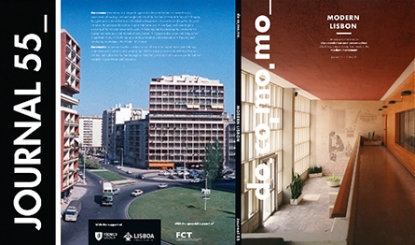New Docomomo Journal 55 (2016/2)!
As a tribute to Lisbon, where the 14th International docomomo Conference – “Adaptive Re-use. The Modern MovementTowards the Future” took place, the argument of this 55th docomomo Journal is Modern Lisbon.
Visit the Docomomo.be publication page here.
 In the words of José-Augusto França, Lisbon “is the last of the old European cities and the first of the modern cities”, asconfirmed by the 1758 Baixa Pombalina plan undertaken for the reconstruction of the city destroyed by the 1755 earthquake, as a pioneering example of modern urban planning.
In the words of José-Augusto França, Lisbon “is the last of the old European cities and the first of the modern cities”, asconfirmed by the 1758 Baixa Pombalina plan undertaken for the reconstruction of the city destroyed by the 1755 earthquake, as a pioneering example of modern urban planning.
Following the avant-garde plan, modern architecture in Portugal may be envisaged through three main moments [1] according to specific policies undertaken during the long Estado Novo dictatorship (1926–1974).
The architects born between 1896 and 1898 began to explore the formal potentialities of reinforced concrete without theMoMo ideological component. Their works coincide with the determinant era of public works. Through the action of Duarte Pacheco, from 1933, Lisbon witnessed a great modernization visible in a large number of key projects: the bridge over the river, the Monsanto park, the marginal Lisbon-Cascais, social neighborhoods and facilities such as hospitals, schools, stadiums, the airport, maritime stations, and the Instituto Superior Técnico, considered the first great modern public work, as the paradigm that took architecture to the scale of the city.
In the postwar period, the premises of the Modern Movement, referenced to Le Corbusier and the expressionism of modern Brazilian architecture, were adopted in an ethical and ideological way, integrating the social responsibility of architecture. It was the rebellious moment when MoMo architecture was globally embraced. The 1st National Congress of Architecture(1948) revealed the new concerns of architects demanding industrialization, their participation in solving the housing problem and the right to participate at the city scale. Architects organized themselves into groups united by common ideals, with the awareness that only a collective work could be effective. ICAT (Cultural and Artistic Initiatives) was created in 1946, around Keil do Amaral, and the magazine Arquitectura was renewed as an instrument for the dissemination of what was being produced in the world …



